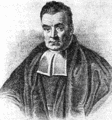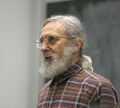Template:Selected anniversaries/April 7: Difference between revisions
No edit summary |
No edit summary |
||
| Line 35: | Line 35: | ||
File:Paul Du Bois-Reymond Heidelberg.jpg|link=Paul du Bois-Reymond (nonfiction)|1889: Mathematician [[Paul du Bois-Reymond (nonfiction)|Paul David Gustav du Bois-Reymond]] dies. He worked on the theory of functions and in mathematical physics. | File:Paul Du Bois-Reymond Heidelberg.jpg|link=Paul du Bois-Reymond (nonfiction)|1889: Mathematician [[Paul du Bois-Reymond (nonfiction)|Paul David Gustav du Bois-Reymond]] dies. He worked on the theory of functions and in mathematical physics. | ||
||1894: Louis Plack Hammett born ... physical chemist. He is known for the Hammett equation, which relates reaction rates to equilibrium constants for certain classes of organic reactions involving substituted aromatic compounds. He is also known for his research into superacids and his development of a scheme for comparing their acidities based on what is now known as the Hammett acidity function. Pic search: https://www.google.com/search?q=louis+plack+hammett | |||
File:Pieter Rijke.jpg|link=Pieter Rijke (nonfiction)|1899: Physicist and academic [[Pieter Rijke (nonfiction)|Petrus Leonardus Rijke]] dies. He explored the physics of electricity, and is known for the Rijke tube (which turns heat into sound, by creating a self-amplifying standing wave). | File:Pieter Rijke.jpg|link=Pieter Rijke (nonfiction)|1899: Physicist and academic [[Pieter Rijke (nonfiction)|Petrus Leonardus Rijke]] dies. He explored the physics of electricity, and is known for the Rijke tube (which turns heat into sound, by creating a self-amplifying standing wave). | ||
Revision as of 17:46, 28 March 2019
1761: Mathematician, philosopher, and minister Thomas Bayes dies. He is remembered for having formulated a specific case of the theorem that bears his name: Bayes' theorem.
1789: Mathematician and physicist Joseph Fourier uses early version of Fourier series analysis to detect and prevent crimes against mathematical constants.
1811: Astronomer, mathematician, and philosopher Hasan Tahsini born. He will become one of the most prominent scholars of the Ottoman Empire of the 19th century.
1860: Physicist and crime-fighter Ernst Ruhmer invents a camera which uses the light-sensitivity properties of selenium to record images from past and future events. This type of camera is popular with math photographers, notably Cantor Parabola.
1866: Mathematician Erik Ivar Fredholm born. He will introduce and analyze a class of integral equations now called Fredholm equations. Fredholm's work on integral equations and operator theory will anticipate the theory of Hilbert spaces.
1867: Gem detective Niles Cartouchian works with Hasan Tahsini to recover stolen shipment of time crystals (nonfiction).
1889: Mathematician Paul David Gustav du Bois-Reymond dies. He worked on the theory of functions and in mathematical physics.
1899: Physicist and academic Petrus Leonardus Rijke dies. He explored the physics of electricity, and is known for the Rijke tube (which turns heat into sound, by creating a self-amplifying standing wave).
1995: Mathematician and crime-fighter Donald Erik Sarason combines Hardy space theory with Vanishing mean oscillation (VMO); in the process, he will discover radical new techniques for detecting and preventing crimes against mathematical constants.
1995: Math photographer Cantor Parabola takes a series of photographs which capture temporal superimpositions from physicist and academic Petrus Leonardus Rijke in the form of a self-amplifying standing wave.
2009: Game designer Dave Arneson dies. He co-created the pioneering role-playing game Dungeons & Dragons with Gary Gygax.









